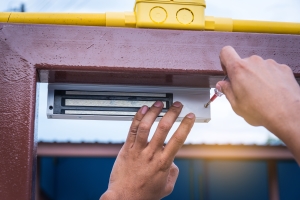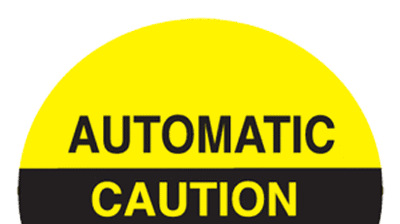MAGNETIC LOCKS THAT FALL FROM OVERHEAD
(Magloc, Maglock, Electromagnetic Lock, Electric Magnetic Lock, Magnetic Lock)
Why they fall and cause injuries / Injury Case Examples
Download PDF of this article here

By Michael Panish
Door & Gate Expert Witness & Consultant
Magnetic locks secure openings with greater holding power and a more secure point of attachment, when energized. A magnetic lock is a heavy metal block that requires professional installation and continual maintenance. The magnet consists of wound copper coils enclosed in a metal case. The contact plate, also known as the armature plate, attaches to the door in most cases, and bonds to the magnet when energized. Both components can and do become loose if improperly installed and/or poorly maintained.
Injuries that result from falling magnetic lock components are common. This does not mean that they are acceptable or unavoidable. In most cases, improper installation techniques combined with inadequate maintenance and substandard observation are the reason for these injuries.
Magnetic locks are commonly used where access is restricted.
Typical installation locations
- Bank ATM vestibules for after hour commerce
- Passage points in facilities that want to limit entry to secure or hazardous areas
- Psychiatric wards where patients must be safely contained.
- Access gates and controlled entry points in parking structures.
- Office building entry points
- Penal institutions
- Limited access stairwells,
- Apartment buildings, hotels, hospitals, labs, condos, and a multitude of other installations that require restricted access where a manual key entry system is cumbersome, impractical, or inadequate.
Magnetic locking devices range in size and weight depending upon the holding power required for the specific location. In general, the size of the device is indicative of the available magnetic potential holding power. Some units are integrated into a systemic alarm system with back up failsafe features that keep the lock active, while others are stand-alone units that can lose function when the power is turned off.
Magnetic locks generally use a copper wound coil to generate the magnetic field when coupled with a steel armature plate. Most installations have the field coils located in a rectangular box installed on a fixed point such as the header of a door frame. Using concealed wires, the fixed electromagnet contained within a metal housing is powered through the frame of the door and the access release point. Either a card key swipe, old-fashioned metal turn-key lock, or other activation device momentarily disconnects the power, interrupting the magnetic field, allowing the door plate to release from the magnet and grant access to the user. In most installations there is a timer set to allow a specific entry time prior to reactivation of the magnetic field.
Due to the materials needed to produce a strong magnetic field, both the steel plate armature and the wound field coils can be quite heavy. These heavy materials require specific attachment and proper installation techniques. As a consultant to hardware manufacturers, it has always been my professional opinion that one of the most basic installation practices along with utilization of good quality appropriately sized and rated installation bolt hardware is to use a thread locking agent. Thread locking agents are designed to essentially glue the threads of a bolt to the tapped hole. Thread lock is now often provided with many hardware manufacturers products in the form of factory applied dry thread coatings or a small tube or bottle of permanent or semi-permanent thread lock liquids.
Depending upon the desired rating of the mag lock, the integration with the door and frame or gate and frame is critical. In repeated magnetic lock installation failures (where components have fallen on people) it has been found that improper hardware has been used for installation. Screws, bolts, or other fasteners were found sheared from usage or the holes where the bolts or screws were installed had been stripped due to improper drilling and tapping. Inadequate thickness of the attachment point backing base materials is also a common cause of disconnection.Read Michael Panish’s Mechanical Fasteners article that discusses injury cases where products that become disconnected from their point of attachment have resulted in serious bodily harm.
Magnetic locks are continually “challenged” due to denied access. They are often not deactivated as expected due to inappropriate codes entered from attempted access points and hold the door closed in the frame. A user may have incorrectly entered an access code, a key card may be unauthorized for entry or the entry point may be turned off for usage due to security reasons. Depending upon the amount of activity for the subject doorway, a magnetic lock can be subjected to years of abuse from these denied entries numbering hundreds of thousands of attempts.
Denied access creates stresses on the points of attachment of both the fixed magnetic coil box and the steel plate that is usually attached to the door with some sort of a swivel connection. If properly configured, a hollow metal door and frame will be manufactured with specific backing plates built into the components that are capable of positively anchoring a magnetic locking system. If proper installation techniques are performed, the hollow metal frame and backing plate will be professionally tapped for the correct bolt hole size. The bolts will engage a solid steel backing block and the bolts will have adequate thread penetration to provide definitive attachment. The installation should utilize a high tensile and high shear strength bolt and chemical thread locking agents will assure long term attachment of the components.
Even with proper placement and professional installation, magnetic locks can become loose. Due to the continuous tugging on an unreleased magnetic lock, the weakest component will often become the source of detachment. That is why it is critical that routine inspections are made of all magnetic locks. Appropriate standards and practices dictate that these inspections should be made by the management of the facility as well as professional service providers. The frequency of inspections depends upon the usage and security requirements of the location and the type of materials used to anchor the magnetic device. Some installations of magnetic locks have used wooden doors and frames. If properly attached and monitored a wood system can provide light duty magnetic lock security. Due to the inherent weakness of wooden doors and frames, openings that have magnetic locks in place, must be closely observed for points of failure.
In higher security installations where magnetic locks are installed, routine monthly or weekly tests of the openings place additional challenges on the door and locking system. Proactive testing to verify that the magnetic lock is fully functional ranges from basic manual pull tests made by a facility staff member to a platform rig designed to quantify and prove the holding strength of the lock. These tests place strain on the points of attachment and should be coupled with a physical examination of the substrate, holding bolts and all components of the lockset to determine that the substructural elements are intact and the components have not cracked or begun to fail in any way.
As a door and gate legal expert, I am contacted frequently regarding injuries due to falling magnetic lock components. I have been the retained expert on numerous legal cases where a magnetic lock failed to work or did not stay attached to the door and frame, as required. Falling magnetic lock components have created serious injuries and wrongful death claims. These claims have happened from diverse locations such as security doors for banks, shopping centers, hospitals, labs, penal institutions, long term care facilities, and hotels - among others. The reasons for these claims vary according to location.
INJURY CLAIM EXAMPLES
The following are examples of injury claims common to many cases involving magnetic locking systems:
- An ATM (Automated Teller Machine) vestibule used after hours had a magnetic lock drop from above onto a bank customer as she attempted to enter the area. The entire incident was recorded on video footage and clearly showed that the customer had no warning and did nothing to contribute to this injury. Recent repairs had been made to the door and frame by a professional service provider that did not address the points of attachment or loose condition of the installation of the magnetic lock system. The bank management relied upon the service provider for the original installation and ongoing maintenance of the doors. The bank was never informed by the service provider that any routine inspection or other proactive measures were needed regarding this specific locking mechanism. The bank took the position that the service provider failed to professionally install and maintain the lock mechanism, and the service provider had the full responsibility for inspections and maintenance.
- A patient in a psychiatric ward (which was known as a high-risk elopement location) became violent, rushed a magnetically locked hallway door, overcame the door through his superhuman strength and ran out of the facility. The patient ran into passing vehicle traffic and was hit by a car and killed. The lock, door, and frame had been improperly maintained and the magnetic force generated by the lock was inadequate to contain this violent patient. When inspected, the magnetic lock that was originally rated for 2500 pounds of holding power was tested and could not maintain a 300-pound pull. The door and frame were found in an extremely deferred condition and the magnetic lock had not been professionally inspected or tested for many years prior to this elopement incident. The maintenance department of this facility was improperly trained and did not perform any routine tests of the magnetic holding power, as was required by the management of the health care facility.
- In a penal institution, Sally port gates controlled by magnetic locks had an armature fall on an inmate as he was passing through the opening while being transported to another location. The gate was approximately 14 feet tall, and the steel mag lock component that dropped on the inmate weighed approximately 7 pounds. The inmate sustained a TBI (traumatic brain injury) and spinal compression from the falling component. The incident was recorded on the facility video cameras. The gates and locks had not been inspected for appropriate attachment for at least 2 years prior to this incident. The gates where the mag lock dropped from were being used on a daily basis.
- A resident of a large apartment complex used card key access to unlock the main entry doors to the lobby. As he was passing through the door pair the heavy magnetic coil of the magnetic lock dropped from the door frame. The 16-pound magnet coil and box swung, dangling only by the supply wiring in an arc straight into the tenant’s face breaking his nose and eye socket. Video footage clearly showed the incident in real time. It was discovered that the building janitors had been notified that there was a problem with the front doors and attempted to perform in-house repairs rather than contact a professional service provider. The mag lock was improperly reinstalled by the janitor using undersized screws that did not hold the lock to the frame. Prior video footage from the same day of the incident showed the magnetic lock dropping from the frame and swinging with the same wire 6 hours before the injury incident.
The above examples are just a few scenarios of injuries caused by improper maintenance and attachment procedures. Magnetic locks are heavy and sharp boxes that fail in many ways and they frequently lead to personal injuries including traumatic brain injury (TBI). There are installation techniques and procedures that generally make these devices safe, if professionally followed and performed. Routine inspections and testing require trained personnel to determine the overall installation and verify that the working condition of the lock is safe for use. Failing to inspect and maintain any door hardware can lead to injuries, but when a magnetic lock falls from overhead it can be deadly.
Michael Panish provides legal expert services for plaintiff and defense claims. He is nationally recognized as an authority on automatic door access points, doors & door components, and gates, and as of 2020, has been retained on over 1600 legal cases since the year 2000. He is a licensed door, lock, and security equipment contractor in the State of California and has installed and serviced door related hardware products since 1976. Mr. Panish can be reached at (888) 902-4272 (ask for Sharon), www.ConstructionWitness.com.



